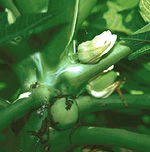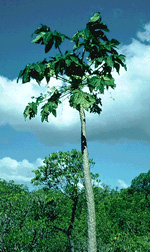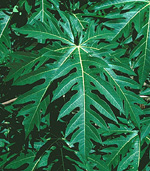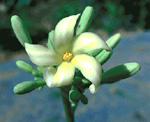 |
The paw paw or papaya (Carica papaya) is the only member for this family found in Australia. It occasionally escapes cultivation in high-rainfall coastal areas of northern and eastern Australia. The family is native to tropical Africa and America.
Characteristic features of the family Caricaceae in Australia include: - small, soft-wooded trees with a more-or-less unbranched, thick trunk and milky sap
- leaves large in a crown at the trunk apex, digitately lobed
- flowers usually unisexual and borne on separate plants
- corolla rotate or tubular, cream
- fruit a large, aromatic, edible berry with numerous black seeds
Description
Evergreen trees or shrubs. Internal secretions of milky sap (latex). Stem internodes spongy or pithy. Plants glabrous. Leaves alternate and spiral, petiolate; pulvinae present. Stipules absent. Lamina simple, symmetric, palmatifid or palmatisect, lanceolate, ovate or orbicular; base cordate; margins dentate or sinuate, ±flat; venation palmate, with the midrib conspicuous, and the tertiary venation reticulate; surfaces not punctate; herbaceous. Male and female flowers occurring on separate plants, or with bisexual flowers and male flowers occurring on some plants, and bisexual flowers and female flowers occurring on others. Inflorescences axillary, cauliflorous or ramiflorous, consisting of glomerules, panicles, cymes or solitary flowers. Bracts present or absent. Pollination by insects. Flowers odourless or fragrant; sessile or stalked. Floral disc absent; floral nectaries on the perianth. Perianth regular, of 2 dissimilar whorls. Calyx segments free or fused, with 5 sepals or lobes, valvate in bud; calyx cup-shaped, herbaceous. Corolla segments fused, with 5 lobes, alternating with the sepals or calyx lobes, imbricate or valvate in bud; corolla wheel-shaped or tubular, white or cream, without contrasting markings, membranous or succulent; lobes ±entire. Fertile stamens 10, opposite to the sepals or calyx lobes, at least partly fused to the corolla, free of the ovary and style, distinct from each other, all ±equal. Anthers basifixed, not versatile, opening inwards by longitudinal slits; 2-celled; with apical appendages. Ovary superior and sessile. Carpels 5, fused; ovary with 1 locule. Style terminal, single and branched above or from the base. Ovules numerous, stalked; placentation parietal. Fruit a fleshy, indehiscent berry; the perianth on the maturing fruit deciduous. Disseminule macro-surface featureless or obscurely costate; micro-surface ±smooth, yellow, orange, grey or black, dull. Seeds numerous per fruit. Aril absent. Cotyledons 2. Embryo straight.
(Note: this description has been generated from the coded data compiled for the key. Any errors in the key data will be reflected in the descriptions.)
A treatment of the family Caricaceae has not yet been published in the Flora of Australia.
Australian genera of Caricaceae (as recognised for the Flora of Australia)
* = all species introduced
*Carica

|
  |

Carica papaya (female flowers)
Photo: S.Pearson © S.Pearson

Carica papaya (habit)
Photo: S.Pearson © S.Pearson

Carica papaya (leaf)
Photo: S.Pearson © S.Pearson

Carica papaya (male flower)
Photo: S.Pearson © S.Pearson
|

| |